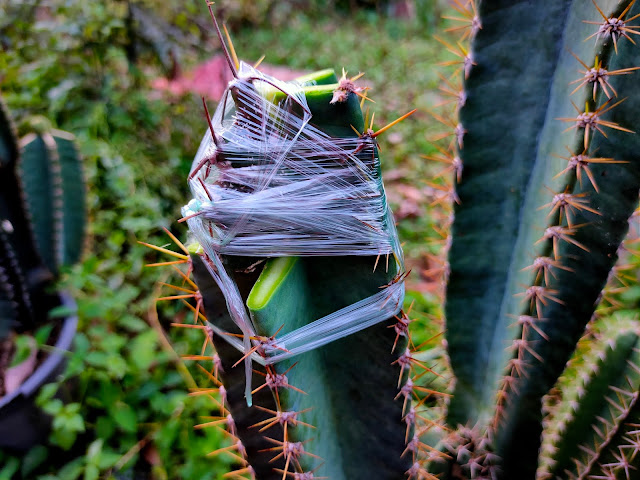Grafting Preparation: Rootstock
How To Fatten Up Your Hylocereus Rootstock For Best Grafting Performance
Up above is the current picture of one of my largest grafted Echinopsis. It was a huge Echinopsis hybrid started from a sad looking butt graft, but the factor that differentiate the vigor is mainly from rootstock. While other half of Echinopsis are grafted on Cereus during this time and another half on Hylocereus yet few are as good as the graft done on big Hylocereus rootstocks.
Thus, I would like to share how I prepare my extra thick and big Hylocereus rootstock. Bear in mind, you need to have a separate Hylocereus grown for fruit production in order to do this. Hylocereus taken from grafting offsets or grown as feral will be short, thin and full of spines.
I will use 'to be pruned' shoots from the mother plants. Usually, I will let them grow to a certain size while taking off their spines regularly. When they hit the right size, I will top off the actively growing shoot and leave them on mother plants for 1 to 3 weeks. The pointy tip will be fatten up and may look caved in, but worry not; as long as you cut young shoot it will remain soft and suitable for grafting.
What if you dont have any Hylocereus grown for fruit? Grow one. All the process to get them start to fruit and throughout the lifespan, you will get tons of sideshoots available to grafting. And believe me, they are very big.
Today harvest, around 7 to 8 pieces of rootstocks taken from 5 poles of Hylocereus. Other than the 7 inch shortest among them, the rest are more than 15 inches. Usually, I leave them up to 12 inch long but this batch is selected to be used for expensive Echinopsis graft later.
They are spineless too, sometime I take a good sideshoots that are not prepared if I saw any. Just have to removed the spine before rooting.
Spine removal helps a lot in growing extra thick rootstock, they will root and fatten up but could not grow any shoot, so they are full of energy to blow up the scion through the roof. Plus, they have no expiry date while rootstock with spines intact will be useless once they put up sideshoots and grow woody.
Here is the top view of Hylocereus rootstock that fatten up on mother plant collected today. As you can see, it is thicker than ordinary Hylocereus offsets taken from grafted rootstocks. Obviously, this kind of rootstock made grafting easy and pushing scion growth better.
This is an example on taking nicely growing offset and removing the spines before rooting. My method of removing spines is same for growing rootstock on mother plant or after cutting it right of the bat.
I use knife and specialized scissor for it, depending on whatever in my pockets. But the scissor is really helpful, it might be one of mankind greatest inventions so far. Easy to use and helpful in dealing with sunken spines.
Now we are ready to root these rootstocks. I use local topsoil, unlike the arid loving cactus, Hylocereus is more into tropical mix of growing media and climate. Plus, I save tons of time but using single growth media for this purpose.
If you are planning to graft in large number, you better grow them in group per pot or polybeg to save space and time. When the are well rooted, you can choose to graft as they are or move them into individual pot. Plus. Start from tallest to short rootstock, you will thank me later.
Now we are done with rooting, in few weeks, this batch will be ready to be grafted. Off course you can graft when they are reddish tender age and without root, I have done that a lot and find that the union does not last long and limited in term of growth rate. Having said so, it is suitable for newly germinated seedling graft as you need small and tender rootstock for young scion.
Below is my recent graft of fully variegated Echinopsis hybrid on huge Hylocereus rootstock.
Now, to end today write up; I would like to share a link to my grafting video using the Hylocereus rootstock.
Now we are done with rooting, in few weeks, this batch will be ready to be grafted. Off course you can graft when they are reddish tender age and without root, I have done that a lot and find that the union does not last long and limited in term of growth rate. Having said so, it is suitable for newly germinated seedling graft as you need small and tender rootstock for young scion.
Below is my recent graft of fully variegated Echinopsis hybrid on huge Hylocereus rootstock.
Now, to end today write up; I would like to share a link to my grafting video using the Hylocereus rootstock.






















































